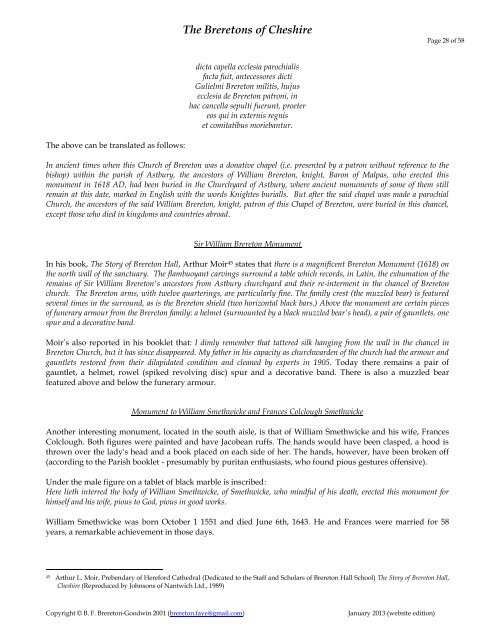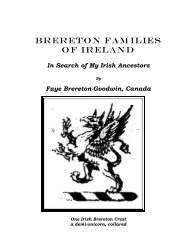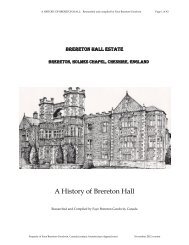You also want an ePaper? Increase the reach of your titles
YUMPU automatically turns print PDFs into web optimized ePapers that Google loves.
<strong>The</strong> above can be translated as follows:<br />
<strong>The</strong> <strong>Breretons</strong> <strong>of</strong> <strong>Cheshire</strong><br />
dicta capella ecclesia parochialis<br />
facta fuit, antecessores dicti<br />
Gulielmi Brereton militis, hujus<br />
ecclesia de Brereton patroni, in<br />
hac cancella sepulti fuerunt, proeter<br />
eos qui in externis regnis<br />
et comitatibus moriebantur.<br />
Copyright © B. F. Brereton-Goodwin 2001 (brereton.faye@gmail.com) January 2013 (website edition)<br />
Page 28 <strong>of</strong> 58<br />
In ancient times when this Church <strong>of</strong> Brereton was a donative chapel (i.e. presented by a patron without reference to the<br />
bishop) within the parish <strong>of</strong> Astbury, the ancestors <strong>of</strong> William Brereton, knight, Baron <strong>of</strong> Malpas, who erected this<br />
monument in 1618 AD, had been buried in the Churchyard <strong>of</strong> Astbury, where ancient monuments <strong>of</strong> some <strong>of</strong> them still<br />
remain at this date, marked in English with the words Knightes burialls. But after the said chapel was made a parochial<br />
Church, the ancestors <strong>of</strong> the said William Brereton, knight, patron <strong>of</strong> this Chapel <strong>of</strong> Brereton, were buried in this chancel,<br />
except those who died in kingdoms and countries abroad.<br />
Sir William Brereton Monument<br />
In his book, <strong>The</strong> Story <strong>of</strong> Brereton Hall, Arthur Moir 45 states that there is a magnificent Brereton Monument (1618) on<br />
the north wall <strong>of</strong> the sanctuary. <strong>The</strong> flambuoyant carvings surround a table which records, in Latin, the exhumation <strong>of</strong> the<br />
remains <strong>of</strong> Sir William Brereton's ancestors from Astbury churchyard and their re-interment in the chancel <strong>of</strong> Brereton<br />
church. <strong>The</strong> Brereton arms, with twelve quarterings, are particularly fine. <strong>The</strong> family crest (the muzzled bear) is featured<br />
several times in the surround, as is the Brereton shield (two horizontal black bars.) Above the monument are certain pieces<br />
<strong>of</strong> funerary armour from the Brereton family: a helmet (surmounted by a black muzzled bear's head), a pair <strong>of</strong> gauntlets, one<br />
spur and a decorative band.<br />
Moir’s also reported in his booklet that: I dimly remember that tattered silk hanging from the wall in the chancel in<br />
Brereton Church, but it has since disappeared. My father in his capacity as churchwarden <strong>of</strong> the church had the armour and<br />
gauntlets restored from their dilapidated condition and cleaned by experts in 1905. Today there remains a pair <strong>of</strong><br />
gauntlet, a helmet, rowel (spiked revolving disc) spur and a decorative band. <strong>The</strong>re is also a muzzled bear<br />
featured above and below the funerary armour.<br />
Monument to William Smethwicke and Frances Colclough Smethwicke<br />
Another interesting monument, located in the south aisle, is that <strong>of</strong> William Smethwicke and his wife, Frances<br />
Colclough. Both figures were painted and have Jacobean ruffs. <strong>The</strong> hands would have been clasped, a hood is<br />
thrown over the lady's head and a book placed on each side <strong>of</strong> her. <strong>The</strong> hands, however, have been broken <strong>of</strong>f<br />
(according to the Parish booklet - presumably by puritan enthusiasts, who found pious gestures <strong>of</strong>fensive).<br />
Under the male figure on a tablet <strong>of</strong> black marble is inscribed:<br />
Here lieth interred the body <strong>of</strong> William Smethwicke, <strong>of</strong> Smethwicke, who mindful <strong>of</strong> his death, erected this monument for<br />
himself and his wife, pious to God, pious in good works.<br />
William Smethwicke was born October 1 1551 and died June 6th, 1643. He and Frances were married for 58<br />
years, a remarkable achievement in those days.<br />
45 Arthur L. Moir, Prebendary <strong>of</strong> Hereford Cathedral (Dedicated to the Staff and Scholars <strong>of</strong> Brereton Hall School) <strong>The</strong> Story <strong>of</strong> Brereton Hall,<br />
<strong>Cheshire</strong> (Reproduced by Johnsons <strong>of</strong> Nantwich Ltd., 1989)




